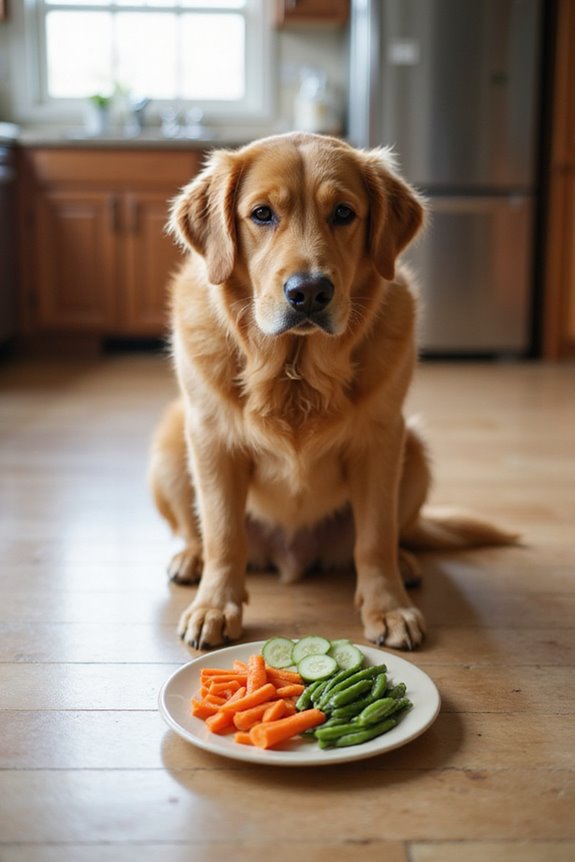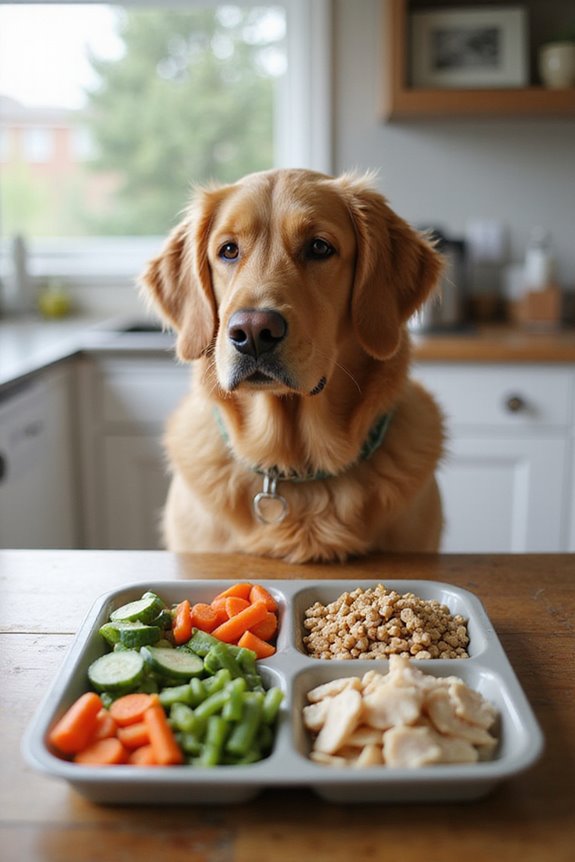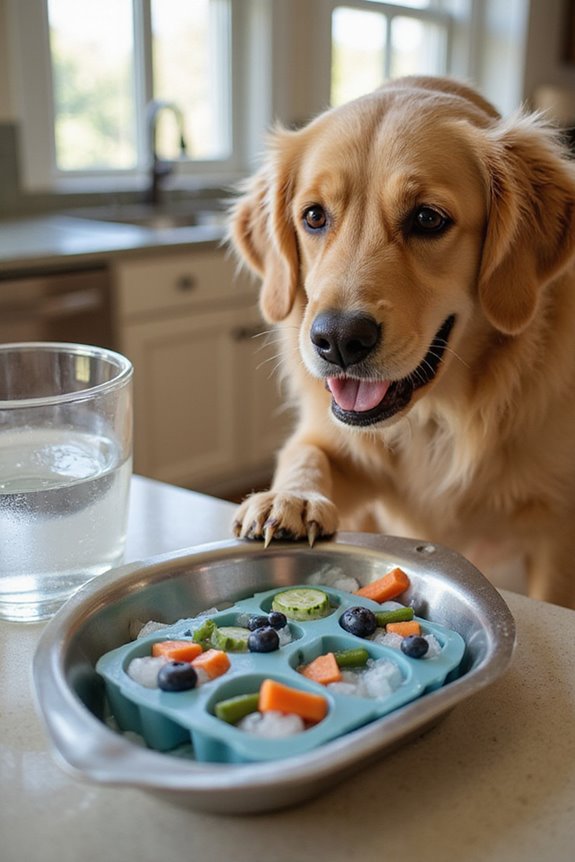When selecting treats for overweight dogs, focus on low-calorie options that support weight management. Safe choices include healthy fruits like apples, blueberries, and watermelon, as well as low-calorie vegetables such as green beans, cucumber slices, and carrot sticks. Fiber-rich alternatives like pumpkin and sweet potatoes can promote satiety. It’s important to monitor calorie intake and consult your veterinarian for tailored advice. Additionally, understanding proper preparation methods and serving sizes is vital. Explore more options below.
Key Takeaways
- Healthy Fruits: Offer low-calorie options like apples, watermelon, raspberries, blueberries, and strawberries, ensuring seeds and cores are removed.
- Vegetable Treats: Include low-calorie vegetables like green beans, carrot sticks, cucumber slices, and cooked asparagus.
- Fiber-Rich Options: Incorporate treats like pumpkin, sweet potatoes, and green beans to promote satiety and support digestion.
- Low-Fat Kibble: Opt for low-fat kibble and veterinary diet options to manage weight and ensure balanced nutrition.
- Monitor intake: Treats should be less than 10% of daily calories; adjust quantities and sizes to help control weight.
Healthy Fruit Treats for Overweight Dogs
When seeking healthy fruit treats for overweight dogs, it’s vital to understand the nutritional benefits each fruit offers, as well as the safety considerations that come into play.
- Apples: Low in calories, packed with vitamin C and fiber, aiding digestion.
- Watermelon: High water content, keeping your dog hydrated, rich in essential vitamins.
- Raspberries: Fiber-rich, low-calorie, promoting fullness and assisting in weight management.
- Blueberries & Strawberries: Antioxidants and vitamins supporting overall health, while being low in calories.
For safe fruit preparation, always remove seeds, cores, and rinds. Start with small, manageable pieces to prevent choking, and introduce fruits gradually. Remember, moderation is key—limit fruit treats to about 10% of your dog’s daily caloric intake. This balance guarantees your furry friend enjoys the fruit variety benefits without compromising their health.
Low-Calorie Vegetable Treats

Low-calorie vegetable treats can be an essential part of a weight management plan for your dog, as they provide vital nutrients without excessive calories. Among these, green beans offer significant benefits, helping dogs feel full while being low in calories. Carrot sticks, on the other hand, should be given with precautions; make sure they’re cut into bite-sized pieces to prevent choking, especially for dogs with diabetes, due to natural sugars. Other excellent options include cucumber slices and zucchini, both hydrating and low in calories. While cooked asparagus can be served occasionally, it must be plain, without any seasoning. Serving these vegetables correctly also aids digestion and keeps your furry friend healthy.
Kibble and Commercial Treat Alternatives

Selecting the right kibble and commercial treats for an overweight dog is essential for effective weight management. Here are some tips to guide your kibble alternatives and treat selection:
Kibble Alternatives
- Choose low-fat kibble formulations designed for weight control, aiming for 18% protein and 6-9% fat.
- Look for veterinary diet options with hydrolyzed proteins for sensitive stomachs.
- Control calorie density, ideally around 3300 kcal/kg.
Commercial Treats
- Select weight control treats that are lower in calories yet palatable, ensuring they meet your dog’s nutritional needs.
- Follow feeding guidelines on the packaging, limiting treats to less than 10% of total daily calories.
Fiber-Rich Treats Beneficial for Weight Management

Incorporating fiber-rich treats into an overweight dog’s diet can greatly enhance weight management efforts, as these treats provide essential benefits that promote satiety and overall health. The fiber benefits are significant; they not only help prevent overeating by making your furry friend feel full with fewer calories but also stabilize blood sugar levels.
When selecting a treat variety, consider options like pumpkin, sweet potatoes, green beans, apples, and carrots. These ingredients offer both taste and nutrition.
Moreover, regularly feeding fiber-rich treats aids in digestive health, ensuring proper bowel function while helping manage obesity-related issues, such as diabetes. By gradually introducing fiber into your dog’s diet, you’ll support their weight loss journey effectively.
Hydrating Treats With Nutritional Value

When considering options for hydrating treats that also offer nutritional value, it’s vital to focus on ingredients that not only quench your dog’s thirst but also contribute positively to their overall health and weight management. Hydration benefits are significant, especially when choosing low-calorie fruits and vegetables like:
- Watermelon, rich in vitamins A and C
- Strawberries, providing antioxidants and fiber
- Cucumbers, over 95% water and low-calorie
Additionally, moisture-rich purees and dairy alternatives such as canned pumpkin purée and goat milk offer both hydration and nutritional balance. They can support digestion while being mindful of calories. Always verify that these treats are prepared safely to enhance health while managing your dog’s weight effectively.
Key Considerations for Treat Safety and Health
Ensuring the safety and health of treats for overweight dogs is essential, as improper selections can exacerbate weight-related issues and endanger their well-being. Here are some key considerations:
- Veterinary Consultation: Always consult your vet before introducing treats, as they provide tailored dietary plans based on your dog’s unique needs.
- Calorie Control: Focus on low-calorie treats to keep within your dog’s daily caloric allowance. Measure treats accurately.
- Treat Timing: Use treats strategically for training, integrating them into a reward strategy that avoids excessive frequency.
- Healthy Ingredients: Opt for natural, single-ingredient treats devoid of harmful additives and avoid sugary options.
- Alternate Rewards: Sometimes, play or affection can serve as effective rewards without the calorie load. Incorporating natural dog treats can also ensure quality nutrition while treating your pup.
These steps can help maintain your dog’s health while still enjoying treats.
How to Properly Prepare Treats
To create healthy treats for overweight dogs, it’s important to focus on proper preparation techniques that maximize nutrient retention and minimize caloric content.
- Ingredient Sourcing:
- Use low-calorie options like lean meats (ground turkey) and vegetables (green beans, carrots).
- Incorporate safe fruits with minimal sugar and starch.
- Employ gentle methods, such as blanching vegetables and using medium-low heat for meats, preserving essential nutrients.
- Avoid overcooking; some pink in meat is acceptable.
- Finely grate or puree vegetables to improve digestibility.
- Allow treat mixtures to cool sufficiently before serving, ensuring safe texture for your dog.
- Treats should constitute no more than 10% of your dog’s total daily caloric intake. For instance, with a 300-calorie allowance, keep treats under 30 calories.
- Adjust treat sizes based on weight; small dogs (3-12 lbs) require minimal portions, while larger dogs (36-50 lbs) can handle slightly bigger treats.
- Regular calorie tracking is necessary to maintain appropriate portion control and avoid excess intake.
- Monitor your dog’s weight; adjust treat servings if you’re not meeting weight loss goals.
Serving Size Guidelines for Treats
Serving size guidelines for treats play a significant role in managing the health of overweight dogs, as adhering to caloric limits is essential for successful weight management. To effectively implement treat portioning, remember these important points:
Tips for Incorporating Treats Into a Balanced Diet
When considering how to incorporate treats into a balanced diet for your overweight dog, it’s essential to approach the process thoughtfully, as the right choices can enhance their overall health without undermining weight management efforts. Here are some effective tips:
- Treat Moderation: Treats should make up no more than 10% of your dog’s daily caloric intake. For a dog needing 600 calories a day, limit treats to about 60 calories.
- Treat Variety: Opt for low-calorie, high-protein, and high-fiber treats that complement their diet.
- Behavioral Use: Use treats during training as positive reinforcement, choosing smaller options to minimize calorie intake.
- Monitor Progress: Regularly assess your dog’s weight and adjust treat quantities as needed to maintain a healthy balance. Including treats like freeze-dried options can be beneficial since they often contain high protein and low calories.
Frequently Asked Questions
Can Treats Replace Regular Meals for Overweight Dogs?
I wouldn’t suggest using treats as a meal replacement for weight management strategies. Treats can be part of a balanced diet, but regular meals are essential for maintaining a healthy dog. Let’s keep them healthy together!
How Often Can Treats Be Given to Overweight Dogs?
Ah, the treat frequency dilemma! I get it; we all want our furry pals to feel special. But remember, portion control’s the name of the game. Let’s sprinkle those treats wisely, shall we?
Are Homemade Treats Better Than Store-Bought Options?
I believe homemade treats are often better than store-bought options. They let me control the ingredients and guarantee a nutrition balance that’s perfect for my pup’s needs, avoiding harmful additives while keeping treats healthy and delicious.
What Are the Signs of a Dog Being Overweight?
I’ve noticed dog obesity indicators like a sagging stomach and palpable ribs. Watching for these signs helps me implement weight management strategies, ensuring my furry friend stays healthy, happy, and full of energy.
Can Overweight Dogs Have Treats During Training?
When I train my overweight dog, I always focus on portion control. Using low-calorie treats and smart training techniques helps keep him engaged without compromising his weight. It’s all about balance and care, right?




